
![]()
14. Shotton In The 20th Century
![]()
Church building is always an indication of an increase in the population of a village and during this period, Shotton changed from a cluster of tiny hamlets into a prosperous industrial town.
Ryeland Street was built in 1903 and consisted of a row of semi-detached houses, which were substantial dwellings for their time. The captains of ships were the first to move into the houses, leaving behind the cramped conditions of their old cottages in Connah’s Quay. By the 1960’s, however, most of the occupants were steelworkers, as can be seen below.
![]()
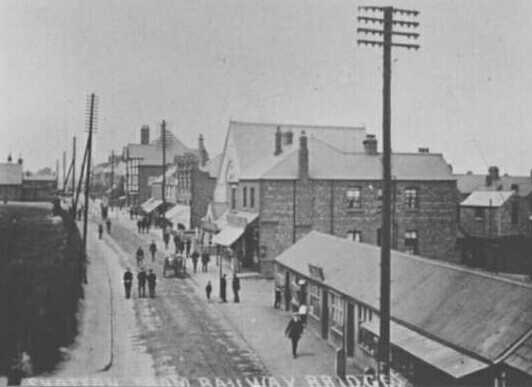
Chester Road West from the Railway Bridge c1910
![]()
Occupation of Male Residents of Ryeland Street Houses
| Number | 1904 | 1967 |
| 1 | Joiner | Steelworker |
| 3 | Steel worker | Bricklayer |
| 5 | Steel worker | Steelworker |
| 7 | Army Officer | Steelworker |
| 9 | Steel worker | Steelworker |
| 11 | ? | Retired School Teacher |
| 13 | Station Master | Steelworker |
| 15 | Slag Works Manager | Steelworker |
| 17 | Reporter | Steelworker |
| 19 | Army Sergeant | Journalist |
| 21 | ? | Steel worker |
| 23 | Ship Captain | Retired Bank Manager |
| 25 | Ship Captain | ? |
| 2 & 4 | Baker | Dentist |
| 6 | Shopkeeper | (Empty) |
| 8 | Steelworker | Steelworker |
| 10 | ? | Steelworker |
| 12 | Ship Captain | Teacher |
| 14 | Ship Captain | Steelworker |
| 16 | ? | Steelworker |
| 18 | Ship Captain | Retired Steelworker |
| 20 | Ship Captain | Accountant |
| 22 | Ship Captain | Steel worker |
| 24 | Wine Merchant | Wine Merchant |
Due to the rapid expansion of the Steelworks in its early years, many people moved to Shotton, especially from Stalybridge, Staffordshire and South Wales, the traditional steel making areas. In 1903 a start was made on building houses in Shotton, for the workers. The first were built in terraces, at right angles to, and between, Shotton’s main road and the Chester to Holyhead railway line. Most of these houses were in Alexandra Street, King Edward Street and Salisbury Street. In order that people could buy property in the area, the "Summers Permanent Benefit Building Society" was established in 1901. The Society loaned money to employees, and repayments were deducted from their wages. In response to this policy, one worker scribed on one of the arches of Hawarden Bridge, "The wages of sin is death, but the wages of Summers is starvation."
The firm continued its policy of providing houses for the workers, and an organisation was set up, known as Sealand Tenants, so that government loans could benefit the house building. In July 1910, John Summers and Sons conveyed 10 acres of their land to the Sealand Tenants, a further 16 acres in 1911 and another 4 in 1913. From 1910 until the war halted the progress, 263 houses on the Garden City Housing Estate at Sealand, were built. The houses there were let to works employees. Originally its name was to be "Sealand Garden Suburb" and it was to have a club at one end of its central axis. Only the south-west half was laid out in accordance with the original plans.
Another event of this period was the opening of the low level railway station in Shotton in 1907. This station has had a chequered history. In 1966 it was closed, but then re-opened on the 17th August 1972 with a new platform standing over the two disused tracks.
![]()
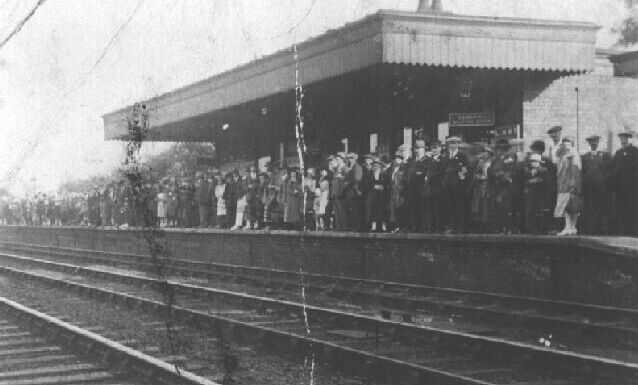
Grosvenor Working Men's Club on an outing from Shotton's low level railway station
![]()
The remainder of the buildings along Shotton’s main road were built between 1906 and 1913, and many new shops opened in this period.
In 1909 an event occurred that would take the name of Shotton to foreign shores. It was the launching of a coaster called S.S. Shotton, at Selby, Yorkshire. The boat was owned by Coppack Brothers, the merchant shipping company of Connah’s Quay. It ferried coal from Cork, and strawberries and potatoes from France.
The top speed of the coaster was 8 knots and she could carry 350 tons of goods.
The name was suggested by Captain Isaac Williams of Higher Shotton. He had worked for Coppacks for many years and, now retired, he lived in a small cottage near Killins Farm.
![]()
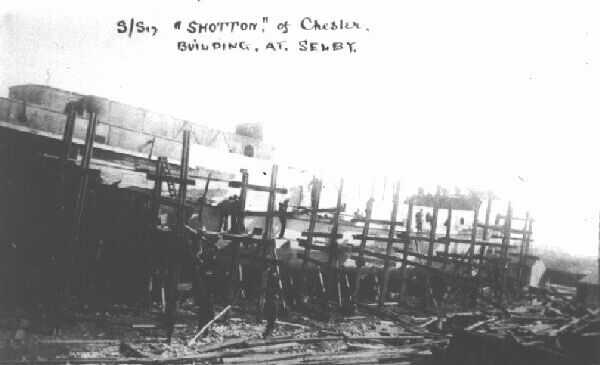
SS Shotton under construction at Selby in 1908
![]()
On 20th June 1924, an appeal was made to the inhabitants of Connah’s Quay and Shotton to raise money for a war memorial to the local people who died in the First World War 1914 - 18. A committee was formed and the site, just across the bridge, on the Connah’s Quay side of the Wepre Brook, was donated by the trustees of the Wepre Hall Estate.
A total of £727 was raised and the memorial was supplied and erected by Edward Jones of Connah’s Quay, on a solid mass of reinforced concrete. The total cost was £879.
The memorial was unveiled on Sunday 1st May, 1927 at 2.15 p.m. by Lieut-Col. T. H. Parry, D.S.O., and was dedicated by the Rev. E. J. Davies.
On a bronze plate on the front of the shaft is the inscription:
"FLANDERS, MACEDONIA, GALLIPOLI,
PALESTINE, MESOPOTAMIA,
AND THE HIGH SEAS.
To Keep In Memory The Men Who Gave Up Their
Lives In The Great War, And As A Thank-Offering
For Those Who By God’s Grace, Survived Its Perils.
This Memorial Is Raised By The People Of Connah’s
Quay And Shotton.
Is it nothing to all ye that pass by?"
On the sides of the pillar are the names of those who died together with the quotation by Rudyard Kipling:
"What stands if freedom fall,
Who dies if England lives.
On the rear of the
pillar is another bronze plate which reads:
"1914 - 1918
For God,
For King,
For Country.
Those Whose Names Are Writ On This Memorial
In Their Country's Hour Of Need
Gave Up All, Trod The Path Of Duty And Passed
Out Of The Sight Of Men
Their graves Are Far And Wide But Their
Memory Abides In Our Hearts.
Their Glory Shall Not Be Blotted Out
Their Name Liveth For Evermore"
In a cavity beneath the monument is an oak chest which contains a time capsule. Together with newspapers, military badges and buttons, is a sealed bottle containing a sheet of parchment on which the names of the committee members is written.
Of course, since the erection of the War Memorial, there have been more wars in which local men and women have been killed. At the front of the monument, a plinth has been added upon which is mounted a plaque listing the names of those who died in World War 2. At the back, mounted on the pillar, another plaque lists those who have died since 1945, including the Falklands War.
![]()
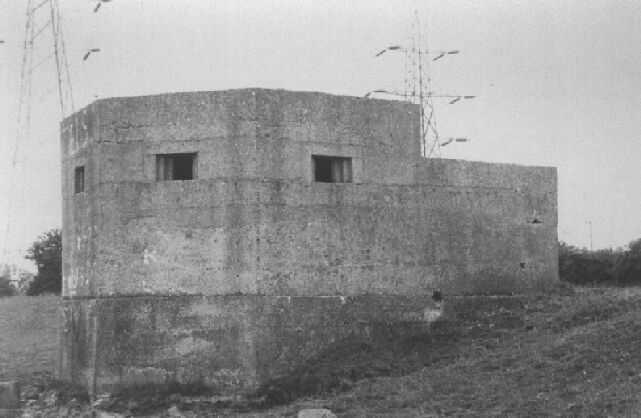
Another reminder of the war can be seen on the river bank. They are known as "Pill Boxes" and were look-out bunkers built during World War 2 to protect the steelworks from enemy boats.
Below: Chester Road West c. 1930
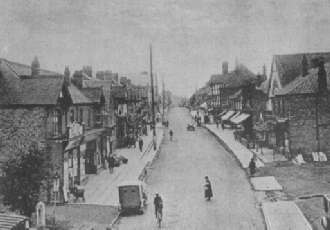
On 1st October 1929 the Deeside Central School, situated in Rowley’s Drive, opened. It was the first Central School to be opened in Flintshire, and the first Headmaster was Stephen Morris, who moved from Custom House Lane School in Connah’s Quay. The site was originally part of the Dee Hall Estate, and the building was designed by R. G. Whitley, the County Architect. The building superintendent was W. Griffiths, the deputy County Architect. The contractors were Messrs. W. F. Humphreys Ltd.. of Acrefair, Wrexham, and the total construction cost was £21,456.
Including the playing field, the area of the site was three and a half acres. The building was constructed of rustic brick walls with artificial stone facing. The roof was of mottled Ruabon tiles and surmounted by an ornamental dome ventilator.
The rooms were as
follows: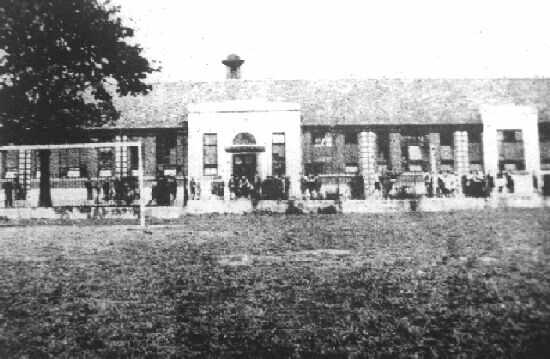
Assembly Hall 56 feet x 30 feet.
10 Classrooms each 24 feet x 20 feet.
Workshop 26 feet x 24 feet.
Laboratory 29 feet x 29 feet.
Art Room 24 feet x 24 feet.
There was also a sitting room, bedroom, dining room, kitchen, pantry and larder for domestic studies, boys and girls cloakrooms and Masters and Mistresses rooms and offices.
The windows were fitted with the new "revolutionary" VITA glass, and all the floors were of oak block.
460 pupils could be accommodated in the school, although only 250 were in attendance when it opened.
Attached to the school, in a separate building, was the Mining Subjects Training Institute. A grant towards the £1,500 building cost was given by the Wrexham Miners Welfare Fund.
It housed:
A Laboratory 30 feet x 24 feet.
A Dark Room (for gas testing training) 6 feet x 14 feet.
A Cloakroom 7 feet x 6 feet.
The official opening of the school was performed on Thursday 14th November 1929 by Sir Henry Hadow, the distinguished educationalist. The opening ceremony was brief and was performed in front of a large gathering..
Sir Henry was presented with a golden key, by the County Surveyor, as a momento.
The children, under the conductorship of the Headmaster, then sang variations of the Welsh Melody "Ar Hyd-Y-Nos."
Speeches were made by Thomas Waterhouse, (Chairman of the Education Committee), Sir Henry Hadow, who spoke about the Central School Movement, J. Bevan-Evans, (Director of Education), Mr. Clayton, (H.M. Inspector of Schools), and Mr. Rhydderch, (former H.M. Inspector).
F. Llewelyn-Jones, M.P. for Flintshire, proposed a vote of thanks to Sir Henry and H. R. Thomas of Flint seconded the proposal.
In 1973 the Deeside Central School became the "Lower School" of Connah’s Quay High School, and it eventually closed in 1986. It is now used by a number of small businesses as the Deeside Enterprise Trust.
![]()
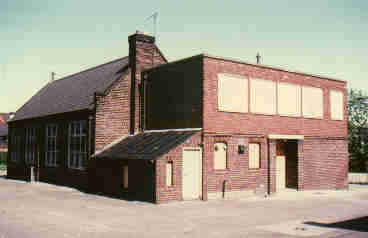 Another
School worthy of mention here is the Venerable Edward Morgan Roman Catholic
School situated at the rear of King George Street.
Another
School worthy of mention here is the Venerable Edward Morgan Roman Catholic
School situated at the rear of King George Street.
It was opened on the 27th March 1927 by the Rt. Rev. Francis J. Vaughan, Bishop of Menevia.
The school closed in 1992 when the infants department was combined with the Juniors at the Caernarfon Close school. The old building was boarded up for several years and won a last minute reprieve from demolition. It now houses Social Services Offices.
![]()
Sport has always been popular in the town and the Shotton Cricket and Football Club was founded as early as 1896. Their grounds were situated where the houses of Chester Close now stand.
In 1907 the two sections of the club separated, and the Shotton Cricket Club moved to new grounds in Shotton Lane, where they still reside today. The Cricket ground is now shared with the Deeside Rugby Club.
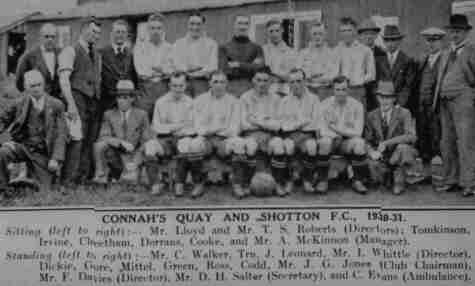
Connah's Quay and Shotton F.C. in 1931

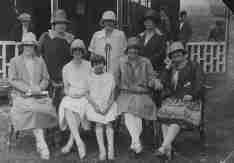
Members of the Shotton Cricket Club and their wives in 1920's
Eventually, the football section combined with Connah’s Quay. Their most successful season was 1928 - 9 when they were winners of the Welsh Senior Cup, the North Wales Coast Cup, the Welsh National League Division 1 and the Welsh Midweek League.
In 1933 a Sports and Fitness Club opened on the site now occupied by numbers 66 and 70 Strickland Street. It was named the "33-Club" and was managed by Fred Fullwood. The opening ceremony was performed by Edward the Prince of Wales, ( who became King Edward VIII in 1936 and abdicated in the same year).
In 1961 the Shotton Westminster Youth Football Club was founded. Their ground was in Shotton Lane, on the site of the Shotton Lane Brickworks, and which is still a playing field today. Amongst their honours, they won the Dodman Cup in 1964/5 and were Youth League Champions in 1965/6.
Left: An Autograph sheet for a charity cricket match held in Shotton on 10th July 1947 with an "All Star" cast.
Click on the picture to see an enlarged version
(Contributed by Terry Parker)
![]()
Copyright © Keith Atkinson 1998 - 2006
You may print out the pages of this website for your own personal use. I do not sell this material in any printed format and therefore if you are offered this for sale, please contact me at shotton@postmaster.co.uk
![]()
Quick Navigation
Home 1 2 3 4 5 6 7 8 9 10 11 12 13 14 15 16 17 18 19 20 21 22